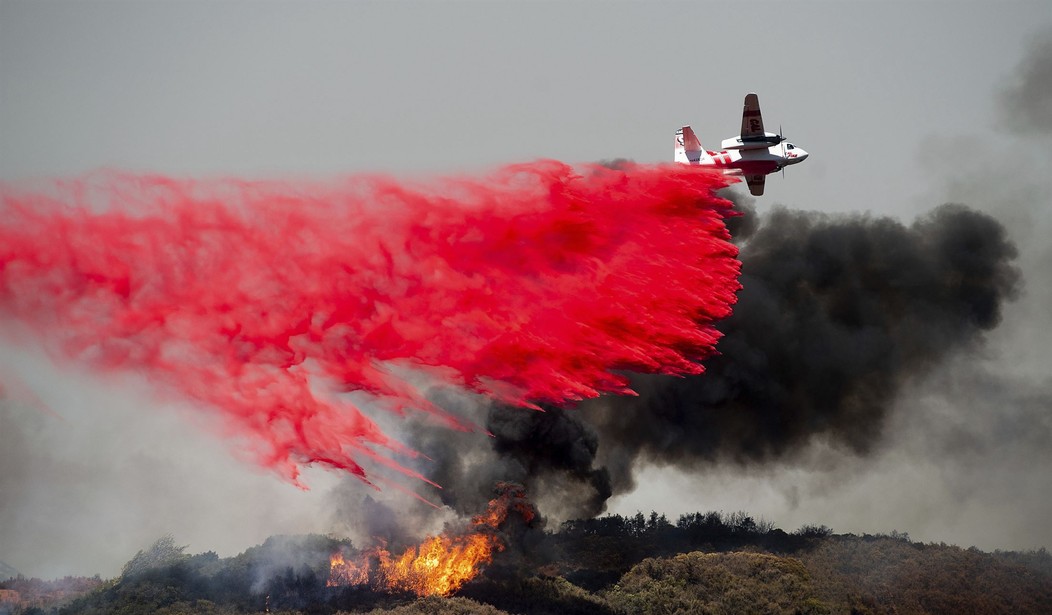More than a dozen wildfires have broken out in California in the past few days. The worst of those by far is the Post Fire which is located north of Los Angeles. The Post Fire has already burned more than 15,000 acres.
Firefighters increased their containment of a large wildfire in mountains north of Los Angeles on Monday after a weekend of explosive, wind-driven growth along Interstate 5.
The Post Fire was 8% surrounded after scorching more than 24 square miles (61 square kilometers) and forcing the evacuation of at least 1,200 campers, off-roaders and hikers from the Hungry Valley recreation area on Saturday.
“That 8% is good because it means we are increasing and bolstering our containment lines,” said Kenichi Haskett, a Los Angeles County Fire Department section chief.
The LA Times has more on the effort to contain the fire and some of the damage it has already done.
The fire, along the 5 Freeway near Gorman, triggered evacuations for 1,200 people in the Hungry Valley Park and Pyramid Lake areas.
The fire burned an auto repair shop, damaged another building and threatened other structures to the south and west of the I-5, authorities said. Los Angeles County Fire Department crews rapidly responded, making aerial assaults with air tankers and water-dropping helicopters.
The Ventura County Fire Department and U.S. Forest Service were aiding in the effort. At one point Sunday, about 400 firefighters and 70 engines were at the scene, according to Cal Fire.
Firefighters were working on the ground and by air to control the spread.
#PostFire Update: Firefighters are making progress utilizing backfiring & burnout techniques to remove fuels between containment lines & main wildfire. The Post fire is 2% contained & 14,625 acres, & continuing to move south towards Pyramid Lake.
— Los Padres NF (@LosPadresNF) June 17, 2024
InciWeb: https://t.co/BxafOpNbNU pic.twitter.com/5S6s3sHjrS
#PostFire I Could not be more proud of the efforts our #ANF firefighters and all the firefighters continue to put in to contain the Post Fire. Preparation , Collaboration and a commitment to serve. (Video of ANF Engine Co. on initial attack)
— Robert Garcia (@firechiefanf) June 16, 2024
🔥🇺🇸 https://t.co/JPheF5jj2Q pic.twitter.com/d81mOHbYZs
Video of the burned out auto shop in Gorman.
Latest from the #PostFire: pic.twitter.com/SyHgvDsIjp
— Logan Hall (@LoganHallNews) June 17, 2024
#postfire Ralph’s road bridge Gorman pic.twitter.com/b9MOBwRvux
— Katie - California LandBird..... (@CaLandBird) June 16, 2024
Again, that's the worst of the current batch but there are more than a dozen other fires burning in California, at least three of which have burned more than 1,000 acres. One of those is the Point Fire near Sonoma.
#PointFire pic.twitter.com/kM3UWmmx33
— Joshua Goodwin (@JoshuaGood30211) June 16, 2024
The #PointFire bumps structures pretty hard off West Dry Creek Rd., Sunday. A gutsy offloading of a @CAL_FIRE helitack crew as the helicopter hovers, and a tanker drop. For more continuous updates please follow @NorthBayNews pic.twitter.com/XBfzwJYfpd
— Kent Porter (@kentphotos) June 17, 2024
A large barn burns as a result of the #PointFire in West Dry Creek near Healdsburg, Sunday afternoon. @NorthBayNews pic.twitter.com/s85rQTbG9R
— Kent Porter (@kentphotos) June 17, 2024
Both of these fires started over the weekend and quickly spread because of high winds which are expected to continue through early tomorrow morning. The fact that these fires cropped up and spread so quickly is definitely a bad sign for the summer to come. All the rain we've had lately means there is a lot more growth out there that could potentially become fuel for a fire.
The Post fire alone seems unlikely to shatter records or cause widespread damage, said Dr. Swain. But the speed of its spread and the fact that it is still only mid-June illustrate why — even after two rainy winters — Californians should be on high alert as the summer unfolds, he added...
A record-breaking rainy season at the end of 2022 and into 2023 followed years of catastrophic drought. There was so much rain that deep into summer and autumn, when fire risk is typically higher, that vegetation that otherwise might be prone to burn was still green and damp.
Last winter in California was also rainy, which spurred the growth of even more vegetation...
“Even though dryness levels are not record-breaking at this point, what is anomalous is just how much fuel there is,” Dr. Swain said.
So we're likely to see more fires starting and some of those could also quickly expand to hundreds or thousands of acres. This is just one of the things that you get used to living in California.









Join the conversation as a VIP Member